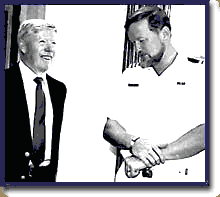|
The Destruction of the HMCS Fraser
Robert Wigmore of Digby, N.S. was only a teenager when he joined the Royal Canadian
Navy at the start of the Second World War, but in the early months of his duty as
Ordinary Seaman on the HMCS Restigouche he was involved in the rescue of fellow
Canadians from the ill fated HMCS Fraser which was destroyed following a collision with
the HMS Calcutta off the mouth of the Gironde River, near Bordeaux, France on June 25,
1940.
On September 1, 1939, the Royal Canadian Navy was placed on active service, with its
main duty during the early months of the war being to protect and escort convoys across
the Atlantic.
On May 24, 1940, Wigmore was onboard the Restigouche which had been slated to go to
the West Indies to relieve the HMCS Fraser which had been dispatched for local defense in
Bermuda. After they pulled out to sea, they received new orders leading them to Europe to
assist in the defense of the United Kingdom, for the German Blitzkrieg had struck in
France on May 23, 1940. The HMC Ships Restigouche, St. Laurant and Skeena were then
rerouted towards England, while the HMCS Fraser was dispatched from the West Indies, and
also routed towards England.
The destroyers pulled anti-invasion patrol along the channel. The Restigouche was sent to
St. Valery-en-Caux to evacuate the 51st Division of the British Army which was
surrounded by the enemy.
The Restigouche was moving closely along the shore in an attempt to rescue the British
division when the German onshore battery opened fire on them. Wigmore said the
German 88 Artillery straddled the Restigouche with the very first shot. Restigouche
Commander, Horatio Nelson, returned the enemy fire and worried that the Restigouche
was well within range. But they never reached the 51st Division.
|
|
With a Lieutenant Groos in charge of the whaler, they made their way closer to the scene of
the disaster, rowers working two on one side and three on the other. Wigmore said there
was very little panic during the rescue operation. He said he could hear survivors aboard
the still floating part of the Fraser singing and the whalers approached. There were between 40 and 50 men from the Fraser pitched into the sea, when bow capsized, but the rear section of the Fraser stayed a float. Many of these crew members were able to jump to their rescuers. In the meantime, the first whaler had managed to pluck 25 survivors from the rough seas and returned to the Restigouche with the boat's capacity of 27 overloaded by survivors. However as they approached the Restigouche with the survivors, the whaler was suddenly swamped as the ship’s propeller pulled the whaler into its wake and all in it were again pitched into the inky blackness of the swollen sea. A number of these were drowned including Wigmore’s fellow crewmember, Able Seaman, George “Scotty” Burnfield of Victoria , B.C. who had only moments before been seated next to him, Wigmore remembered in horror. All during the rescue, all of the vessel's lights were kept on, including the search lights. They fully expected to be attacked at any moment by enemy submarines or aircraft, but not one light was dimmed. The lights not only helped the rescuers ascertain the position of survivors, but gave courage to those who waited in the inky waters to be rescued. Forty five members of the HMCS Fraser died that night but another 118 were saved due to the efforts of the crew of the HMCS Restigouche. The remnants of the Fraser were then scuttled after important papers and salvageable equipment were removed. Unfortunately, many of the survivors of the HMCS Fraser who had been transferred aboard Fraser’s replacement HMCS Margaree were lost in October of 1940 when it collided with the freighter Port Fairy. Ordinary Seaman Wigmore was among those honoured for his efforts in the rescue of the survivors. Wigmore served a total of 24 years in the navy eventually becoming an RCN Chief Diver. |


